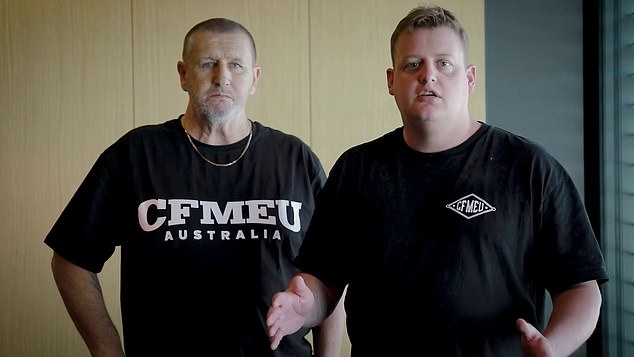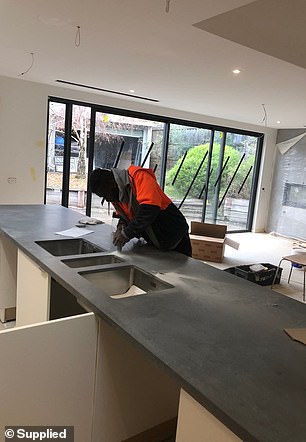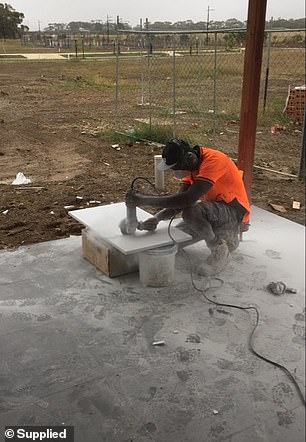Engineered stone protests: Angry union members rally in their thousands outside state’s parliament calling for national ban on silicosis-causing kitchen product
Thousands of angry trade unionists have gathered in a state parliament as part of their campaign to ban a deadly kitchen product. They say politicians will have ‘blood on their hands’ if it is not banned.
Traditions from the CFMEU union marched from Sydney’s Belmore Park to the NSW State Parliament on Macquarie St on Thursday morning to loudly protest their safety concerns.
“Manipulated rock is killing workers right now,” CFMEU Secretary Zach Smith said in a video promoting the rally. Engineered stone is most often used to make kitchen and bathroom benches.
“One in four workers in NSW alone have been diagnosed with silicosis or another form of fatal dust-related illness while working with this product.
“In all but the rarest cases, that diagnosis is a death sentence.”
Thousands of angry trade unionists (pictured) have gathered in a state parliament as part of their campaign to ban a deadly kitchen product
The union launched its ‘Stop this killer stone’ campaign to call on federal, state and territory governments to ban the import, production and use of artificial stone.
“But if governments don’t do that, we won’t stand idly by, we’ll be introducing our own workplace bans from July 1, 2024,” Mr Smith said.
Speaking before a meeting of workplace health and safety ministers from across Australia on Friday, he said tradies “must send them the clearest message possible that now is the time to ban this product that is causing the deaths of workers.”
The union’s NSW secretary Darren Greenfield said they should do so.make sure these politicians understand (if artificial stone is not banned) that they will continue to kill workers.
“If they don’t stop it, we will continue until we have to, to defend the lives of working people in this state and in this country,” he said.
In the absence of legislative action, the ACTU this week threatened to enforce its own ban that would prevent the stone from being brought to or used on Australian construction sites.
More than 600,000 workers nationwide have been exposed to respirable crystalline silica, which can lead to silicosis: a debilitating and incurable form of lung disease.
Unions and traders affected by the disease have called on the government to ban the product, but have faced significant opposition from the industry, which claims safe working practices are the solution.

CFMEU national secretary Zach Smith (right) and NSW secretary Darren Greenfield (left) are leading the campaign

Australian tradies in their 20s and 30s are falling desperately ill from lung disease, many of which result from working with a popular stone used in high-end kitchen renovations (photo: Joshua Suwa, 34-year-old silicosis sufferer, with his wife Erin and children Hudson and Lenny)


Mr Suwa (pictured) developed silicosis and scleroderma after working as a stonemason for nine years, five of them in Sydney and four in Melbourne
For stonemason Joshua Suwa, 35, the diagnosis has turned his world upside down.
‘I was doing well in my career, I was the breadwinner for my family; “We have two beautiful young boys, and now I can’t work in any area where I use my hands, I can’t really physically play with the kids – it’s very tough,” he said.
Speaking to Daily Mail Australia, the father-of-two said he was absolutely in favor of a complete ban on the product, but questioned the motives of the slow-moving government.
‘I honestly think it makes a lot of money. The government still wants it there, no matter how powerful it is and how much of an impact it has had on people’s lives.”
He said he appreciates the union’s decision to take a stronger stand against artificial stone because he knows firsthand the damage it can cause.
Mr Suwa played high-level football in western Sydney and developed the disease after working as a stonemason producing and cutting artificial stone for kitchen renovations between 2015 and 2019.
‘It’s hard to breathe, even though I’m talking now, I have to sit. “I can’t walk and talk at the same time,” he said.
The damage to his lungs has not worsened, but the autoimmune disease he has as a result of his diagnosis “causes him a lot of distress.”
Anthony Albanese met with silicosis survivors in 2021 to discuss the crisis, pledging to fight for workers’ rights if elected.
‘Everyone has the right to be safe at work. But these workers were not,” he said.
“We needed a national effort to tackle asbestos and the cruel diseases it causes. And we need a national effort to tackle silicosis.
‘I promise that a Labor government will stand up for workers affected by silica dust.’

Mr Albanese’s government has been accused of not being tough enough on artificial stone
Now Mr Albanese’s government is being accused of not being tough enough on artificial stone.
The Greens said Australia was ‘witnessing the asbestos of the 2020s’, despite NSW costs showing it wouldn’t cost a dollar to introduce a ban.
“There is no safe level of exposure to silica,” NSW Greens health spokeswoman Abigail Boyd said on Thursday.
‘Victoria has regulated the concentration of artificial stone on silica below 40 per cent and workers are still being exposed to dangerous levels of silica dust and contracting silicosis.’

